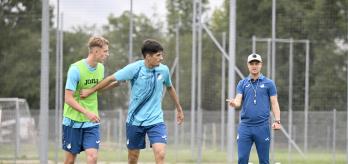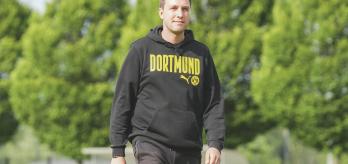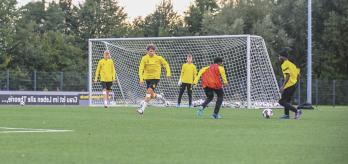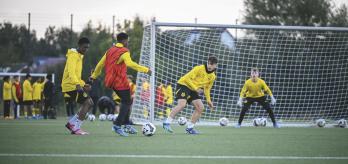You are now in your second season as U19 coach at TSG 1899 Hoffenheim. How did you come to be in the frame for the job one year ago?
Tobias Nubbemeyer: The head of the TSG Academy at that time, Jens Rasiejewski, wanted to go back to the club’s roots and base the playing style of the academy teams more closely on Ralf Rangnick’s ideas: aggressive defending, instant counter-pressing and swift transition. Jens was looking for someone who embodies this philosophy and implements it consistently. I was exactly what he was looking for, so it didn’t take long for us to reach an agreement.
Why were Rangnick’s ideas no longer so prevalent?
Ralf Rangnick was the coach in Hoffenheim until early 2011 and, of course, over time, his ideas were diluted. Changes were made at management level, while training content also develops and adjusts to the trends in football. In recent years, many Hoffenheim teams have defined themselves in terms of possession, but my aim was to achieve the exact opposite of this. The possession game is also important for me, but I believe that everything starts with defence, sprints and transitions. These are the cornerstones, the foundations for everything else. The next step is then to talk about build-up play, how we make ourselves available, or how we bypass the opponent’s line.
What is so fundamental about your out of possession behaviour?
We want to close down aggressively, high up the pitch, anticipate how our opponent will behave, and apply pressure with targeted sprints, without having to check. We will always be hunting. We will display toughness and assertiveness in challenges, to win the ball and launch attacks towards the opponent’s goal as quickly as possible.
What happens if someone sets off on a sprint too late?
We sprint towards the opposition from a compact baseline. The gaps between the players are small, keeping them connected, and they move collectively in a unit. The players furthest from the ball shift across and are always choosing between potential passing options, which is how we try to always stay in touch with the opponent. If one of our players sprints towards the player in possession but loses out, the next player will already be underway. The gaps between our players are so small and the connections within our network are so good that we can quickly apply pressure again, induce errors, and win possession, even when we are being outplayed. We only drop back in exceptional cases, such as the opponent launching a counter-attack.
How do you convey this playing style to your team? How did you approach this “system switch”?
It was crucial for me not to deviate from my approach. Of course, I did need to convince them to start with, but as last season progressed, we started to get “in step” with one another and, at some point, everyone was on board. The wins showed the team how we can be successful, and how much fun it can be to play this way. This season, we had to play with a numerical disadvantage against SC Freiburg for some time. Some players in the team wanted to drop deeper and “park the bus” so I had to take a stand at that point. I simply won’t drop deep, even when we’re one player short. I made it clear that we would continue with the high press, and the positive moments in the game showed the boys why this way of defending can be successful.
Do you have a particular strategy for imparting that information?
My convictions are the foundation for my actions and my passion for this style has to shine through. I stand for aggressive defending, chasing the ball and swift transition. If you exemplify this passion and combine it with triggers in training to repeat and exaggerate the behaviour you want to see, then at some point you will spark something in the players and they will pass that enthusiasm on to others.
Last season, Kelven Frees was the player in my team who was on my side very quickly, embodying my style of play. I frequently praised his behaviour, showing the team what my expectations were. In the end, he became one of three captains.
What happens after you win the ball?
As far as possible, we focus on speed after we regain possession, aiming to exploit the disarray among the opposition ranks and score a goal. There were good examples of this in the league games against Borussia Dortmund or against 1. FC Kaiserslautern. Of course, we have ideas for when we are in possession, but when I took charge we had to focus on laying the foundation for off-the-ball play.
Starting from structured possession, what is your plan?
We want to use our short-passing game to shift the action into the opposition half. The short passing distances force the defenders to keep moving and simultaneously help us to construct a tight network. If the opposition is sitting deep, we will set up in their half and when they go to a high press, we attack the space in behind. We lure the opposition into concentrating build-up play on one side, and then switch to the other side to combine our way out of pressure.
So, we are not like a Roberto de Zerbi team, staying behind the ball and enticing the opposition into our half. Instead, we are on the move, shifting the ball to break that compact structure.
In one interview, you talked about how you wanted to get to the opposition goal in just three passes after gaining possession. Are you aiming to employ this direct style of play?
Playing through the middle is our priority, but if the defence puts a stop to that then we will attack down the wings. Therefore, the number of passes required to set up a shot always depends on how the opposition plays. Sometimes we need five or six passes – and sometimes it takes ten. We look at how the other team is pressing and how the opposition’s out of possession behaviour, formation, and style of play open up space for us. That approach determines whether we need to shift the play, or launch a direct breakthrough. For example, in the German championship final, Borussia Dortmund sat deeper when pressing and attempted to hit us on the break. We then made more use of the half-spaces to create a numerical advantage in midfield. Using short passes to entice the defenders to step up allowed us to quickly get into space.
How do you define your coordinated behaviour in possession?
My assistant coaches analyse the opposition and then, on and off the pitch, they show the players how the other team presses and the space that we need to dominate. In matches, we coach the lads and adjust things as the situation requires. However, we do employ some simple principles, such as “occupy all spaces”. We want just one player out on the wing, with at least one in the half-space and the central area, something that often happens automatically as a result of our formation in possession. Spreading out in this way enables us to attack all five areas at any time. You tie up the opposition across the width of the pitch and can make a deep diagonal run towards goal, regardless of the location of the ball.
To ensure that we have a numerical advantage in the centre, we just have one player on the wing. Having two players on each wing would see us automatically concentrate play there, and there would be fewer connections between the team units. And without those connections, there is no energy on the pitch and it becomes difficult to gain momentum.
You talk about energy and momentum. How do you recognise these on the pitch?
The area where the action is taking place determines the location of the momentum. The opposition have the momentum if the ball is near your goal more often. If your team has set itself up in the other half and your players are winning the important duels, you have the upper hand.
Our objective is to shift the action to the opponent’s half, put them under pressure in front of their own goal, and force errors. We want to impose our style of play on the opposition, so if the game is taking place in front of our goal, we have to change something.
Sometimes, the opposition is content to stay put in their own half, trying to hit you on the break.
We are grateful if that happens, as it lets us approach the goal without much resistance. We will suffocate any attempts to break out with our defending and counter-pressing. Of course, that does not work every time: Heidenheim did manage to score three goals against us from counter-attacks this season. We have a few new players and they are still in the process of internalising our style of play as a team. As time progresses, we are developing defenders who give absolutely everything to protect their own net and we are currently fine-tuning our behaviour in 1v1 and focusing on defending against one-twos. We are also working on speaking a common language.
How do you ensure that the team speaks this common language?
Well, I will interrupt the session if there is no connection between the players in training and their actions are not coordinated. I will address it right away. If I just brush it under the carpet, I am saying that it is okay for it to happen again in the next exercises or match situations.
Synchronicity, by which I mean coordinated behaviour, is extremely important to me and I try to promote that. If the atmosphere is generally positive, that helps to make connections, which is not the case if players are quarrelling and moaning. I pay very close attention to these situations and address them directly, preferring to make more use of positive examples than negative ones. We want to create a training culture that allows leaders to develop. They should embody our communication principles and support one another in a positive manner, while demanding that others share their high standards. Our actions and our training culture support and protect their behaviour.
Put simply, there is a difference between shouting at someone for not making a run and motivating that player to really go for the next sprint. I have developed a keen awareness of different tones of voice and types of communication, and it does not take long for me to realise if something is amiss in the training staff or in the team. Then I act appropriately to get everything back on track.
How do you promote positive actions and mutual support?
On the one hand, we motivate the players and encourage them to act positively during the sessions, and we also use one-to-one conversations to highlight their actions and stimulate some critical self-reflection. If someone uses an accusatory tone, there can be no synchronicity, no connection between the players. We hold up the mirror and provide an approach that can solve the issue in the future. Small changes to the way we behave have a significant effect on team-mates.
At this age, many of the lads are lacking self-awareness and do not appreciate how their actions can affect others. After a misplaced pass, they just shrug or turn around and do not see the effect it has on other players. Sometimes, a hug can help: a sign of affection like that can elicit quite a response. Sadly, some players think that they and their actions are not so important. For example, if the eighteenth player in the squad thinks that a hug will help his team-mate to perform better on the pitch, then we have a better chance of winning as a team. It always boils down to communication and reflection.
How often do you have one-to-one conversations?
We don’t have a fixed schedule to define when to have these chats, but approach the boys as the situation demands. For example, there is a lot of communication with this team during training. The players bottle up too much in the way of emotion and don’t express their feelings but they need to be able to be happy, and also vent their anger. On any given day, I have up to five one-to-one conversations. At the same time, I support the lads during the sessions and I try to find the right moment to coach them, all the while ensuring that I behave like a role model. In order to inspire others to do something, you have to be really passionate yourself.
What do you expect from your players?
I expect them to act in a way that benefits the team, and to develop intuition about each other. However, the first step is for them to be at peace with themselves. They need to be aware of their role in the team, and considering their team-mates is the next step. A lot of players struggle with that, as it is not something they have been familiar with in the past. If the focus is on competition, the players find it difficult to be there for one another. This can create a disconnect for some who see themselves as first-choice players but often find themselves on the bench.
If they know their role, it is possible to take a different view of the situation: I will give it everything in training and show that I am a contender by playing that pass, because I want to win with my team. That is how I push the key players, while helping the whole team to improve. However, some think of themselves first, to the detriment of shared objectives and their own development. The team is the key to success. Last year, we stuck together as a team and we saw how far that solidarity can take you.











